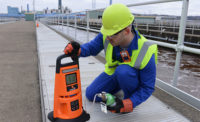How digital control of work will improve health and safety in oil and gas
Changing realities and growing responsibilities

Smederevac / iStock / Getty Images Plus
In the popular imagination, the oil and gas industry is plagued by worker injuries and fatalities, an impression fed by high-profile disasters like Deepwater Horizon. In reality, the oil and gas industry has sophisticated health and safety programs that have contributed to an effective safety culture with an incident rate lower than that of many other industries. According to the American Petroleum Institute, the nonfatal injury and illness rate in U.S. oil and gas in 2021 was 1.6 per 100 full-time workers, which compares to a rate of 2.7 per 100 workers for the rest of U.S. private industry.
However, according to a recent report from the International Organization of Oil & Gas Producers (IOGP), data suggests that health and safety is encountering some problems, including increases in fatal accidents, incident severity, and LTIR (Lost Time Incident Rate). Among the proposed causes for these increases, three merit particular attention.
Control of Work is a critical component
First, the oil and gas industry increasingly relies on a growing number of less-experienced operators, contractors, and suppliers in addition to its existing workforce of seasoned experts. Much of this is the result of the industry hiring more workers to keep pace with increased demand, which is unlikely to ease up in the near future. The International Energy Agency has forecast that the global demand for crude oil in 2023 will reach 101.9 million barrels per day (bpd), which is 2 million bpd above the forecast for 2022. The world’s voracious appetite for oil and gas means the industry needs to ramp up its workforce considerably. With the demand for workers outstripping the skills in the talent pool, this situation is leading to some shortcomings in workers’ training and situational awareness, which makes the workplace less safe for everyone.
Second, many worksites are plagued by poor risk mitigation and ineffective Control of Work. Control of Work is a critical component of maintaining safety in a complex environment. It is a systematic approach to the work procedures, risk assessments, and documentation that form the safety management system and ensure that workers are engaging in their tasks safely and with the proper training and prerequisites. Control of Work addresses activities such as isolation management, shift handover, simultaneous operations (SIMOPs), contractor management, and all the associated training and documentation. The fundamental goal of Control of Work is to ensure worker safety through operational excellence and process efficiency. When Control of Work is done poorly, injuries and fatalities become much more likely to happen.
Permit to Work is an integral component of Control of Work. Permit to Work mitigates risk by enforcing a process that defines the scope, controls, and personnel associated with hazardous activities. Permit to Work ensures there is sufficient insight into controls and conflicts between activities, and it creates centralized permits for review and approval before any hazardous activities can begin.
Without effective Control of Work and Permit to Work, hazardous activities such as work with energy sources or in confined spaces can lead to increased risk of injuries or fatalities, especially in the complex work environments found in the oil and gas industry.
Finally, with the exponential increase in oil demand and regulatory requirements comes a heavier administrative workload, which reduces workers’ opportunity to focus on core safety responsibilities and risk mitigation activities. When workers are spending a disproportionate amount of time focusing on administrative duties instead of health and safety, the threat of injury or fatality becomes more severe. Conducting audits, manually collecting data for regulatory reporting, and navigating disparate technology systems can consume significant amounts of time to the detriment of focusing on health and safety. Further, organizations that are lagging in their digitalization and are instead using outdated manual and paper-based processes will find that they are not only at high risk of falling behind their regulatory obligations, but they are also leaving very little time in the day for health and safety practitioners to focus on their core job of keeping workers safe in a potentially hazardous environment.
Digital processes can help mitigate risk
Digitalization of Control of Work is a necessary condition for health and safety excellence in every organization. Tasks such as risk assessment and management, inspections, asset management, and Permit to Work are increasingly difficult in organizations that are shouldering the burden of growing market and regulatory pressure the way oil and gas is today. Protecting the health and safety of a workforce that spans downstream, midstream, and upstream oil and includes experienced workers, teams, lone workers in isolated areas, workers at height, workers underwater, and an army of contractors, many of whom are young and inexperienced, is no longer possible using manual processes, disparate and obsolete technology systems, or paper. Twenty-first-century Control of Work requires massive amounts of data, automated methods for collecting it, rigorous data quality standards, and real-time analysis to provide predictive solutions that anticipate and prevent incidents before workers are injured or killed.
Permit to Work is a critical component within Control of Work where digitalization can provide positive results. With manual processes, knowledge isn’t always available to the people who need it to make real-time decisions that keep workers safe. Permit to Work provides the ability to review, route, agree to, and authorize work before it begins, which highlights any threats or conflicts that could put workers in danger. By ensuring these processes are digital instead of manual, Permit to Work supports a more effective flow of information for everyone in the organization, including contractors and lone workers.
Further, digital processes produce the data that safety practitioners need to track trends, understand the relationships and risks of simultaneous work, and facilitate a predictive approach to health and safety that prevents injuries and fatalities before they happen.
As regulatory and market demands continue to increase the pressure on the oil and gas industry, organizations with poor Control of Work processes will see declines in the effectiveness and impact of their health and safety programs. As shown in the IOGP data, we are already seeing the leading edge of this problem in the form of increasing rates of fatal accidents, incident severity, and LTIRs. Retiring outdated, manual methods of Control of Work and Permit to Work and implementing digital processes will help to support a culture of safety in oil and gas that adapts to rapid market changes and puts safety at the top of the business agenda.
Looking for a reprint of this article?
From high-res PDFs to custom plaques, order your copy today!





